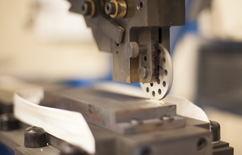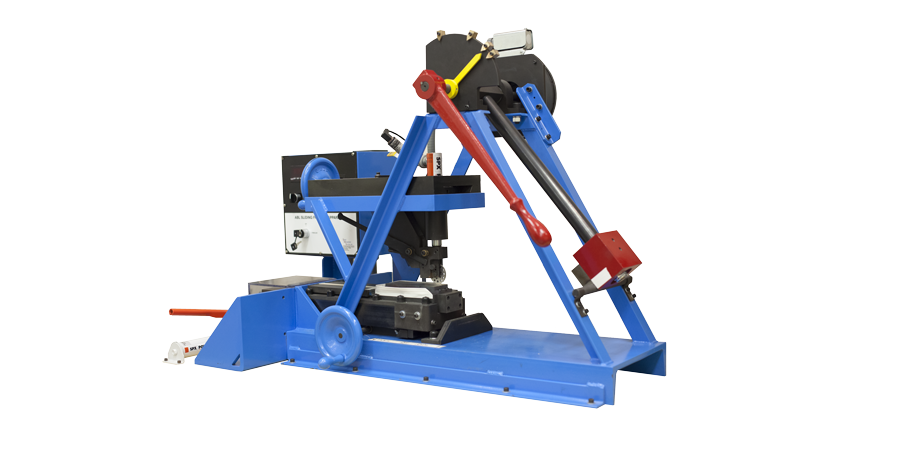Safety Management Services, Inc. (SMS™) manufactures the ABL Friction Test Machine for clients who require in-house testing capability to determine energetic material response to friction energy stimulus. The ABL friction test machine is one of the industries core sensitivity test machines for producing energetic material sensitivity data.

The ABL Friction Test is designed to impart a known (downward) force onto the test sample while moving two control surfaces relative to one another, at a known velocity. This is designed to simulate an in-process scenario where two objects have energetic material captured between them and slide past each other creating a friction event. For the ABL Friction test, an energetic test sample is placed on a steel plate (anvil); a steel disc is then lowered into contact with the test sample. The steel disc is pressed onto the sample with a hydraulic ram until the desired force is achieved. The steel plate is then struck by a swing hammer that moves the plate 1 inch at the designated velocity. The velocity of the plate is controlled by the drop height of the swing arm. For low-speed measurements (0 – 3 feet/sec) the anvil is moved by attachment to a chain pull drive system. The speed of the anvil is controlled by using a variable speed motor to drive the chain.
ABL Friction Tet Machine
Reaction of the material (go vs. no-go) is determined by operator observation, detection of decomposition by a gas analyzer, or utilizing the SMS developed GoDetect-View™ high speed video capture system. The ABL Friction machine is capable of producing sensitivity data in engineering units for direct correlation to in-process energy. The sensitivity data is used to determine critical safety parameters related to manufacturing and handling of the materials being tested.
High Speed Video of Friction Sensitivity Testing
The ABL Friction machine produced by SMS has been adopted by both the UN and the ET Users’ Group (Explosive Testing Users’ Group, www.etusersgroup.org) due to the following:
- Compliance to established industry standards for test methodology
- Applicability to historical data
- High level of fabrication controls (i.e. flatness, hardness, surface finish)
- Capable of producing data in engineering units for in-process energy comparison
- Standardized operating procedures for controlling test variables
- Equipment calibration
- Verified and repeatable test results through a lab validation process
SPECIFICATIONS
Complies with:
• UN Test Manual, Test 3 (b) (iii): Friction Sensitivity Test, and Test 3 (b) (iv)
• TB700-2, Section 5-3c
• MIL-STD 1751A, method 1021
OPERATING RANGE
• 0 - 3 ft / sec velocities using low speed drive
• 3 - 8 ft / sec velocities using pendulum
• 0 - 1000 pound hydraulic force
• 1-inch friction plate travel with adjustable guides for drift reduction
STANDARD HARDWARE
• Low speed drive system
• High speed drive system
• Digital force read-out
• Calibration kit
• Adjustable wheel and anvil allows for new testing surfaces for each trial
• Friction Plates (5) with certified flatness, hardness, and surface finish
• Friction Wheels (10) with certified cylindricity, flatness, hardness, and surface finish
• 3-phase, 220V or 110V power
OPTIONAL HARDWARE
• Reaction detection system
• High speed video
• Data aquisition system including laptop
• GoDetect software (inquire for more details)
• Economic SMS ABL Tabletop Friction Machine without low speed drive
SAFETY FEATURES
• Electromagnetic safety brake with logic controls for operator safety
• Pendulum safety bar
• Operator shielding
SMS Tabletop ABL Friction Machine
Safety Management Services, Inc. (SMS™) manufactures an SMS Tabletop ABL Friction Test Machine as an economical alternative to the SMS ABL Friction Test Machine. Like the SMS ABL Friction Test Machine, the SMS Tabletop ABL Friction Test Machine also provides in-house testing to determine the energy required to initiate a sample by friction energy application.
The SMS Tabletop ABL Friction Test Machine reduces cost and size by eliminating the low speed drive used when testing extremely sensitive materials. The majority of tests that are run using the ABL Friction Test Machine do not require the use of the low speed drive because the sensitivity level can be found at the velocities created by the pendulum. The smaller size of the test apparatus allows it to be mounted to any stable workbench or table.
The primary parts of the test apparatus are similar to the ABL Friction Test Machine and include a moving anvil, stationary wheel, and swinging pendulum. The test sample is placed on the moving anvil and the stationary wheel is lowered, using a hydraulic ram, until it pinches the sample against the moving anvil. A specified load, indicated by a digital readout on the main junction box, is applied to the sample by the stationary wheel. The swinging anvil is raised to one of four indicated heights and released, striking the moving anvil. The moving anvil travels a distance of approximately one inch, moving the sample underneath the stationary wheel. Depending on the height of the pendulum, the anvil moves at a calibrated maximum velocity of 3, 4, 6, or 8 ft/sec. After testing, engineering units for the sensitivity results are easily obtained.
Sample initiation is determined by production of smoke, fire or an audible pop. Gas detection by infrared sampling analysis is also possible. The SMS Tabletop ABL Friction Test Machine can be pared with GoDetect™ System to increase reaction detection efficiency.

